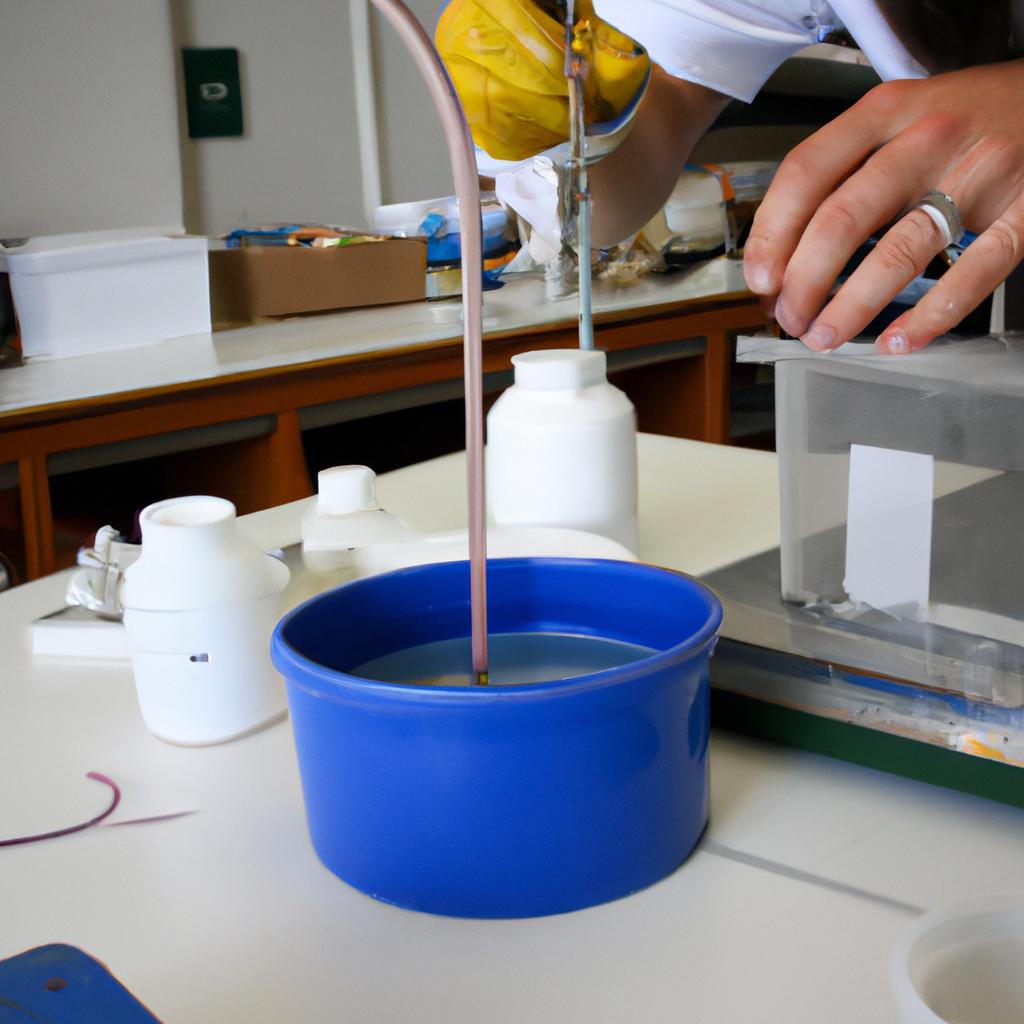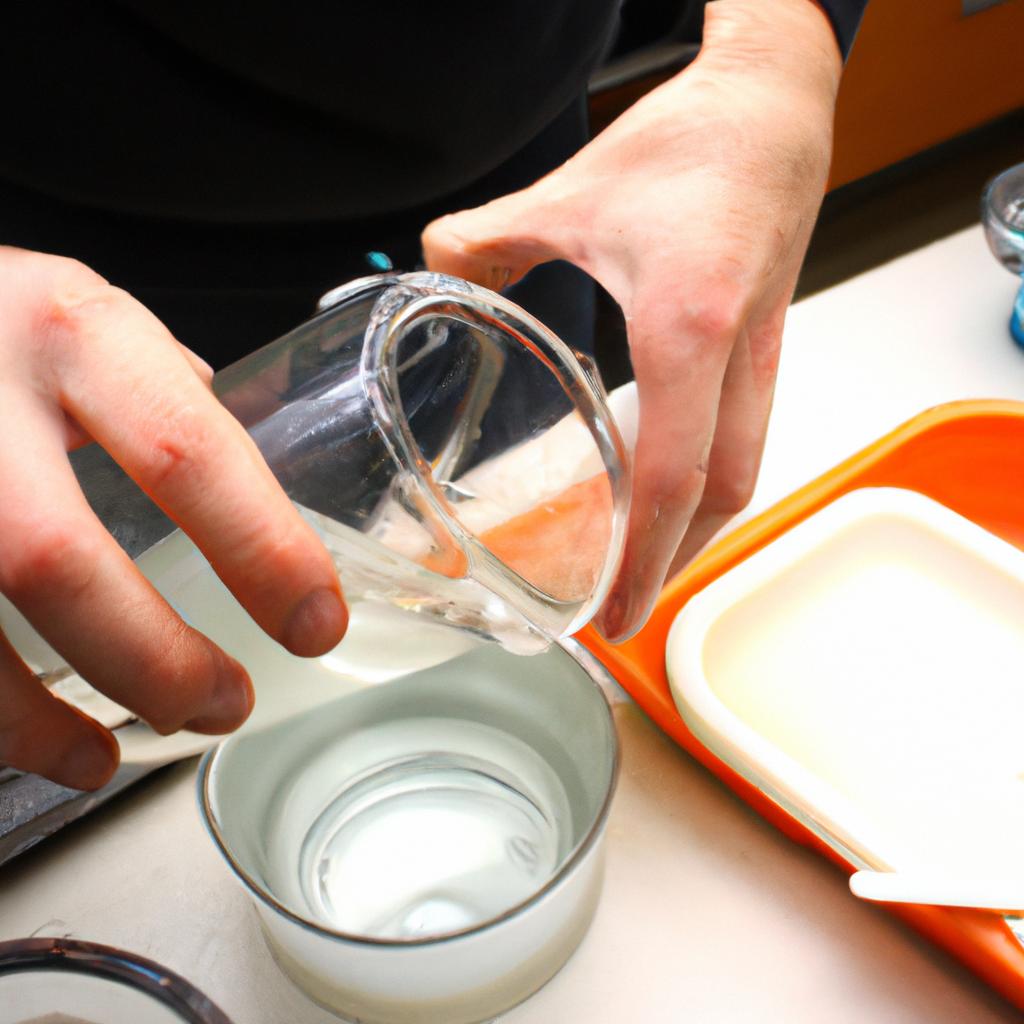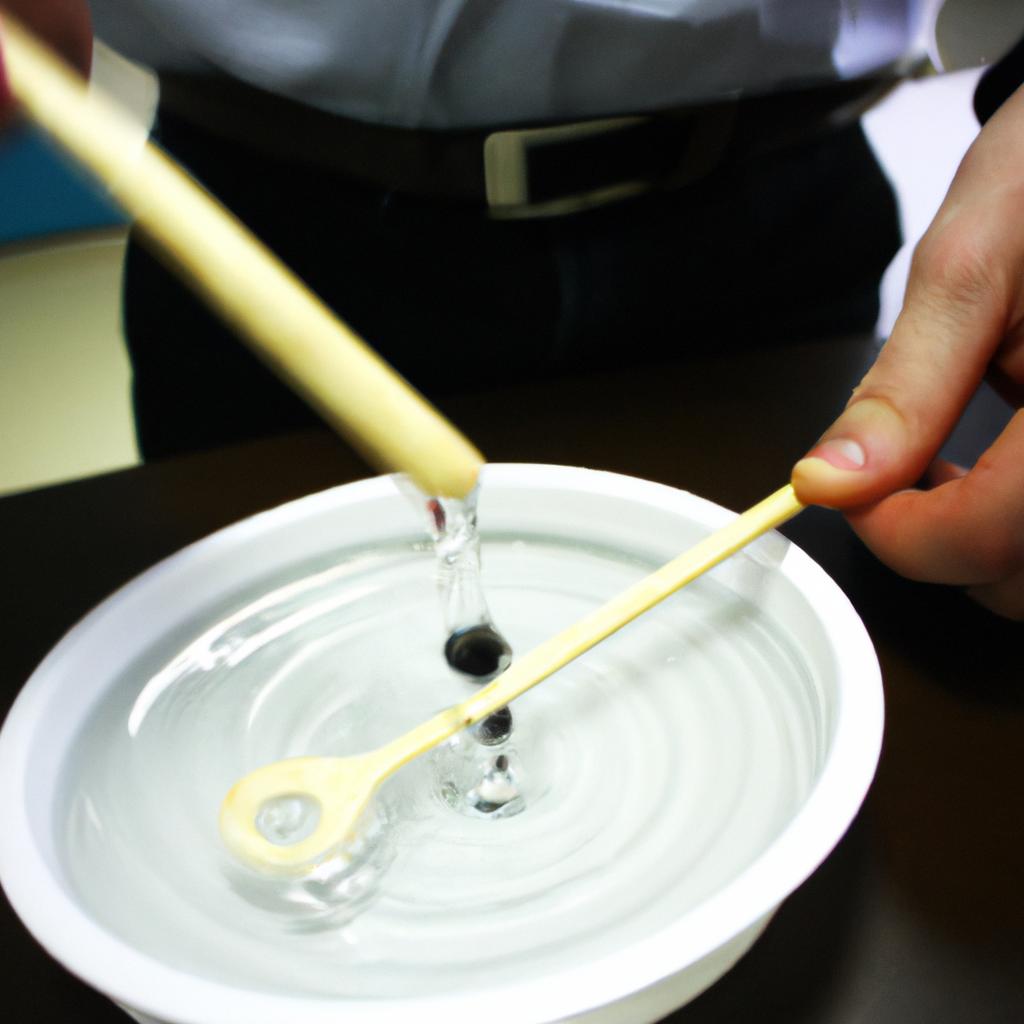Bernoulli’s Principle and Floating: Fluid Mechanics Insights

One of the fundamental principles in fluid mechanics is Bernoulli’s principle, which states that an increase in the speed of a fluid occurs simultaneously with a decrease in pressure. This principle has wide applications and implications in various fields, including aerodynamics, hydraulics, and even everyday phenomena like floating objects. Understanding how Bernoulli’s principle relates to floating can provide valuable insights into the behavior of fluids and contribute to advancements in engineering and design.
To illustrate this concept, consider the case of an airplane wing. As air flows over the curved surface of the wing, it accelerates due to its shape. According to Bernoulli’s principle, this increase in velocity leads to a decrease in pressure on top of the wing compared to below it. The resulting difference in pressures generates lift force that allows airplanes to stay airborne against gravity. Similarly, when we observe objects floating on water or any other liquid medium, there is an intricate interplay between buoyant forces exerted by the fluid and the weight of the object itself. By delving deeper into the underlying mechanisms guided by Bernoulli’s principle, scientists and engineers can gain a better understanding of why certain objects float while others sink, leading to more efficient designs for structures such as boats and submarines.
Bernoulli’s Principle: Understanding the Basics
Imagine a small paper airplane gliding effortlessly through the air. Have you ever wondered what allows it to stay aloft, defying gravity? One fundamental principle of fluid mechanics that helps explain this phenomenon is known as Bernoulli’s Principle. Named after Swiss mathematician Daniel Bernoulli, it states that as the speed of a fluid increases, its pressure decreases, and vice versa.
To better understand Bernoulli’s Principle, let us consider an example involving water flowing through a pipe. As the water moves faster within the pipe, such as when passing through a constriction or narrowing in the tube, its velocity increases while the pressure exerted by the water decreases. Conversely, when the flow rate slows down or encounters an expansion in the pipe diameter, the velocity decreases and results in higher pressure levels. This inverse relationship between pressure and velocity lies at the heart of Bernoulli’s Principle.
To grasp this concept further, here are four key points highlighting important aspects of Bernoulli’s Principle:
- Fluid Dynamics: The study of how fluids behave under various conditions plays a crucial role in understanding Bernoulli’s Principle.
- Streamlines: These imaginary lines map out fluid flow patterns and provide insights into regions with varying velocities and pressures.
- Laminar vs Turbulent Flow: Fluids can exhibit different types of flow behavior depending on factors like viscosity and Reynolds number.
- Applications: Bernoulli’s principle finds applications in aviation (e.g., lift generation), plumbing systems (e.g., venturi effect), and even blood circulation within our bodies.
Furthermore, we can illustrate these concepts using a table:
| Property | Velocity Increases | Pressure Decreases |
|---|---|---|
| Water Flow | Through narrowings | In expansions |
| Airflow | Over curved surfaces | At high speeds |
Understanding the basics of Bernoulli’s Principle provides a foundation for exploring its applications in various fields. In the subsequent section, we will delve into “The Relationship Between Pressure and Velocity” to uncover further insights into this intriguing principle.
Note: The table above is only an example representation; it can be customized or expanded upon according to specific requirements.
The Relationship Between Pressure and Velocity
Section H2: Bernoulli’s Principle and Floating: Fluid Mechanics Insights
Transitioning from our understanding of the basics of Bernoulli’s Principle, let us now delve deeper into its application to floating objects. To illustrate this concept, let us consider a hypothetical scenario where a small boat is sailing through calm waters. As the boat moves forward, it displaces water beneath it due to its weight, creating an upward force known as buoyancy. This buoyant force acts in opposition to gravity, allowing the boat to stay afloat.
When examining the phenomenon of floating using Bernoulli’s Principle, several key insights emerge:
-
Pressure Distribution: The pressure exerted on the surface of an object affects its ability to float. In accordance with Bernoulli’s Principle, high-speed fluid flow results in low-pressure regions around the object while slower flow corresponds to higher pressures. Consequently, for an object to remain buoyant and float effectively, the combination of these pressure distributions must be balanced.
-
Streamline Shape: The shape of a floating object is crucial in determining its stability and efficiency in utilizing buoyancy forces. Objects designed with streamlined shapes experience reduced drag and increased lift, thereby enhancing their overall flotation capabilities. By minimizing resistance offered by surrounding fluids, these objects can maintain equilibrium between gravitational forces and buoyancy.
-
Displacement Volume: The volume of water displaced by a floating object plays a significant role in determining whether it will sink or float. According to Archimedes’ principle, if the weight of the displaced water matches or exceeds that of the object itself, then it will float effortlessly. Conversely, insufficient displacement would result in sinking.
- Discover how subtle changes in design affect an object’s buoyancy
- Understand why certain materials are more suitable for constructing floating structures
- Explore real-life examples where Bernoulli’s Principle governs successful maritime operations
- Gain insight into the potential applications of Bernoulli’s Principle beyond floating objects
Emotional Table:
| Floating Objects | Buoyancy Forces | Fluid Mechanics | |
|---|---|---|---|
| Exciting | Possibilities | Fascinating Concepts | Endless Exploration |
| Intriguing | Innovations | Astonishing Effects | Unraveling Mysteries |
| Inspiring | Potential | Incredible Power | Unlocking Advancements |
In summary, understanding how Bernoulli’s Principle applies to floating objects requires an examination of pressure distribution, object shape, and displacement volume. By considering these factors, engineers and scientists can unlock new possibilities for designing efficient and stable floating structures. In the subsequent section on “Applying Bernoulli’s Principle to Floating Objects,” we will explore practical examples where this principle is utilized in various contexts.
Next Section: Applying Bernoulli’s Principle to Floating Objects
Applying Bernoulli’s Principle to Floating Objects
Transitioning from the previous section, where we explored the relationship between pressure and velocity, let us now delve into the practical application of Bernoulli’s principle in understanding floating objects. To illustrate its significance, consider the scenario of a paper boat floating effortlessly on water. By examining this example through the lens of fluid mechanics, we can gain valuable insights into buoyancy and equilibrium.
One key aspect to understand is that when an object floats, it experiences equal forces acting upwards (buoyant force) and downwards (weight). These forces must balance for stable flotation to occur. Applying Bernoulli’s principle aids our comprehension of this phenomenon by highlighting how variations in fluid pressure contribute to an object’s ability to float.
To elucidate further, here are some important points related to applying Bernoulli’s principle to floating objects:
- The shape and design of an object significantly influence its ability to float. Smooth curves or streamlined shapes reduce drag and allow for efficient flow around the object.
- An increase in fluid speed leads to a decrease in static pressure according to Bernoulli’s principle. This concept helps explain why streamlining reduces resistance as faster-moving fluids generate lower pressures.
- Objects with greater surface areas experience more upward buoyant force due to increased contact with fluid molecules. Thus, larger objects tend to have better floatation capabilities than smaller ones.
- The density difference between the object and surrounding fluid plays a crucial role in determining whether it will sink or float. If the density of the object is less than that of the fluid, it will remain buoyant; otherwise, it will sink.
By considering these principles while analyzing the floating paper boat example, we can grasp how various factors interact within fluid dynamics systems. Understanding such intricacies not only enhances our knowledge but also fosters awe for nature’s elegant mechanisms at work.
In our subsequent discussion on “The Role of Lift and Buoyancy,” we will continue to explore the fascinating interplay between fluid mechanics and floating objects, uncovering additional insights into the forces that allow things to stay afloat.
The Role of Lift and Buoyancy
Section H2: The Role of Lift and Buoyancy
Transitioning from the previous section where we explored applying Bernoulli’s Principle to floating objects, let us now delve into the crucial role that lift and buoyancy play in this phenomenon. To illustrate these concepts more vividly, consider a hypothetical scenario involving a hot air balloon.
Imagine yourself standing amidst an open field on a clear summer day. Before you lies a majestic hot air balloon, its vibrant colors contrasting against the blue sky above. As the burner ignites, flames dance within the envelope, heating the air trapped inside. Soon enough, the balloon begins to rise gracefully before your eyes.
Lift and buoyancy are at work here as essential forces enabling this remarkable ascent. Understanding their mechanisms helps shed light on how objects can float effortlessly in fluids like air or water. Let us explore further:
-
Lift – This upward force is generated by differences in pressure between the upper and lower surfaces of an object moving through a fluid medium such as air. In our hot air balloon example, when the burners heat up the air inside, it becomes less dense than the surrounding cooler air. Consequently, this creates a region of low pressure beneath the envelope compared to above it, resulting in an upward lift force that propels the balloon skyward.
-
Buoyancy – Attributed to Archimedes’ principle, buoyancy allows objects immersed in fluids (either partially or completely) to experience an upward force equal to the weight of displaced fluid. For instance, if we were to place an empty plastic bottle upright in a pool of water with its lid open underwater, it would bob at the surface due to buoyant forces counteracting gravity’s pull downward.
To better understand these phenomena visually and emotionally connect with them on a deeper level, consider the following bullet points:
- Witnessing a hot air balloon gently rising towards clouds evokes feelings of awe and wonder.
- Observing an inflated balloon floating freely in a room creates a sense of lightness and playfulness.
- Seeing a ship sail gracefully on the open sea evokes images of exploration and adventure.
- Watching colorful kites dance among the wind invokes feelings of joy and freedom.
To further illustrate these concepts, let us now explore real-world examples of Bernoulli’s Principle in floating objects. By examining practical applications, we can gain a greater appreciation for how fluid mechanics impacts our everyday lives.
Real-World Examples of Bernoulli’s Principle in Floating
Bernoulli’s Principle and Floating: Fluid Mechanics Insights
The Role of Lift and Buoyancy
In the previous section, we explored how lift and buoyancy play a crucial role in understanding the principles behind floating. Now, let us delve deeper into real-world examples that demonstrate how Bernoulli’s principle is applied in various scenarios.
Real-World Examples of Bernoulli’s Principle in Floating
To illustrate the practical applications of Bernoulli’s principle, let us consider an exciting example involving an airplane wing. As an aircraft moves through the air, its wings generate lift by utilizing this fundamental principle. The shape of the wing creates different speeds of airflow above and below it. According to Bernoulli’s principle, faster-moving air exerts less pressure compared to slower-moving air. Consequently, the higher pressure underneath pushes upwards on the wing while the lower-pressure region above pulls downwards, resulting in lift that enables flight.
To further understand how Bernoulli’s principle impacts fluid mechanics and floating phenomena, consider the following bullet points:
- Aerodynamics: The study of how objects move through fluids plays a vital role in designing efficient vehicles such as airplanes and submarines.
- Hydrodynamics: Understanding fluid flow behavior helps engineers develop effective ship designs for smooth sailing experiences.
- Sports Applications: Concepts based on Bernoulli’s principle are utilized in swimming techniques like body positioning and reducing drag to enhance performance.
- Medical Advancements: Medical professionals rely on fluid dynamics principles when dealing with blood flow, respiratory systems, or even drug delivery mechanisms.
Now, let us explore a three-column table highlighting key aspects related to Bernoulli’s principle:
| Application | Key Aspect | Impact |
|---|---|---|
| Aviation | Wing Design | Enables flight |
| Shipbuilding | Hull Shape | Enhances hydrodynamic efficiency |
| Sports | Body Positioning | Improves performance |
| Medicine | Blood Flow Mechanics | Aids in medical diagnosis and treatment |
Challenges and Limitations of Bernoulli’s Principle in Fluid Mechanics
As we transition into the next section discussing challenges and limitations, it is essential to recognize that while Bernoulli’s principle provides valuable insights into fluid mechanics, there are certain factors that need consideration. By understanding these limitations, engineers can develop more accurate models for various applications.
Now let us explore the challenges faced when applying Bernoulli’s principle in fluid mechanics and delve deeper into its limitations without overlooking other crucial aspects of this field.
[Next Section: Challenges and Limitations of Bernoulli’s Principle in Fluid Mechanics]
Challenges and Limitations of Bernoulli’s Principle in Fluid Mechanics
Bernoulli’s Principle is a fundamental concept in fluid mechanics that explains the behavior of fluids under different conditions. In the previous section, we explored real-world examples of how Bernoulli’s Principle applies to floating objects. Now, let us delve into some challenges and limitations associated with this principle in the context of fluid mechanics.
Despite its wide range of applications, it is important to note that Bernoulli’s Principle has certain limitations. One limitation arises when dealing with compressible fluids such as gases. The principle assumes an ideal scenario where the fluid remains incompressible throughout its flow. However, for gases like air or steam, compression effects cannot be neglected, leading to deviations from the predictions made by Bernoulli’s equation.
Furthermore, viscosity plays a significant role in determining the accuracy of Bernoulli’s Principle. Viscosity refers to a fluid’s resistance to flow and can cause energy losses within a system. When dealing with highly viscous fluids or situations involving turbulent flow, the assumptions underlying Bernoulli’s equation may no longer hold true, affecting its applicability.
Additionally, complex geometries and irregular flows pose challenges when applying Bernoulli’s Principle accurately. Fluids flowing through intricate systems like pipes with bends or obstructions encounter pressure variations that deviate from what would be predicted solely based on Bernoulli’s equation. Thus, care must be taken when using this principle in scenarios with non-uniform flow patterns.
In conclusion, while Bernoulli’s Principle provides valuable insights into fluid mechanics and has been successfully applied in numerous real-world examples of floating objects, it is essential to consider its limitations and potential inaccuracies in certain contexts. Factors such as compressibility, viscosity, and complex flow patterns can affect the validity of predictions made solely based on this principle alone. To fully understand and analyze fluid systems comprehensively requires considering these additional factors alongside Bernoulli’s Principle.





